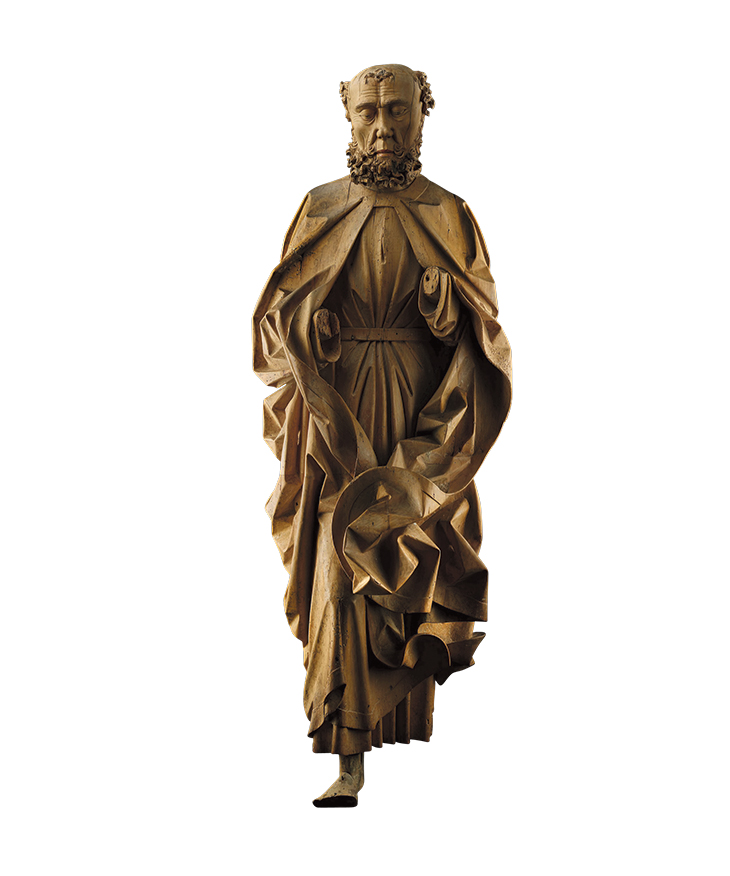The cream of the art and antiques world once again gathers in the MECC in Maastricht for TEFAF (16–24 March); this year, some 300 dealers from 20 countries bringing a total of around 35,000 objects spanning seven millennia. While the event is divided into its usual eight sections – Ancient Art, Antiques, Design, Houte Joaillerie, Modern, Paintings, Paper, and Tribal – the Modern section for 2019 has been swelled by 13 new exhibitors, out of 28 newcomers to the fair overall. Below is our final instalment of Susan Moore’s picks of the fair – catch up on part one here and part two here.
Saint Sebastian (1525), Marco Palmezzano
Piacenti, €300,000
The martyred saint Sebastian was a favoured subject of Palmezzano, who spent most of his life working in or around his home town of Forli, and the landscape of the Apennine foothills is lyrically evoked in his paintings. Signed and dated 1525, this panel is rendered in a style deeply rooted in the previous century.
Saint Sebastian (1525), Marco Palmezzano. Piacenti, €300,000

Saint Peter (c. 1500), Circle of Veit Stoss
Senger Bamberg Kunsthandel, €280,000
The Nuremberg master’s manner of carving dramatic drapery in billowing but crisp and deeply cut linear folds that culminate in a distinctive ear-shaped twist is evident here, as is the expressive and highly individualised features of the apostle. Lined and gaunt, Peter gazes down to his flock with all the gravity and dignity to be expected from this leader of the early Christian Church.
Saint Peter (c. 1500), circle of Veit Stoss. Senger Bamberg Kunsthandel, €280,000

Man with a Turban (c. late 1620s), Jan Lievens
Nicholas Hall, price on application
A discovery from the French private collection and hitherto unpublished or exhibited, this panel is a ‘tronie’, a type of painting favoured by both the young Lievens and his contemporary Rembrandt. The two shared a studio in Leiden – and sometimes the same models – for about five years until 1631. Often painted from life and striking in their physical features and exotic costumes, these imaginary character heads act as testimony to the artists’ technical and expressive prowess. Unlike Rembrandt’s tronies of the period, however, this example reveals the influence of the Utrecht Caravaggisti in its dramatic light, but it is the verve and variety of textures and techniques that mark it out. Turban and flesh are wrought by thick layers of impasto, while a web of fleshy folds and wrinkles are woven out of short, quick brushstrokes made in different directions. For the beard, the application of pigment is thin and the handle of the brush is pulled backwards through it to uncover a lighter ground and suggests wisps of hair that catch the light. Hall, a new exhibitor, will be presenting a group of tronies.
Man with a Turban (c. late 1620s), Jan Lievens. Nicholas Hall, price on application

Pair of Louis XVI beaker vases (second half of the 18th century), France
Galerie Léage, €150,000–€200,000
The cobalt-blue glaze – known in the West as ‘powder blue’ – was a Kangxi specialism, and its subtle, speckled surface came from the glaze being blow on to the unfired porcelain body through a gauze-covered tube. In this pair of hexagonal vases, the cloudy surface is further enhanced by arabesques and stylised landscapes enamelled in gold. Chased gilt-bronze mounts top and tail the vases, the extraordinary handles formed by entwined serpents.
Pair of Louis XVI beaker vases (second half of the 18th century), France. Galerie Léage, €150,000–€200,000

Alexander tetradrachm (c. 325–323 BC), Babylon
Art Ancient, £4,650
Boldly struck in high relief at the Babylon mint during the lifetime of Alexander the Great, this silver tetradrachm bears an image of Heracles wearing the skin of the Nemean lion, its jaws around the hero’s ear and its paws tied around his neck. The reverse, depicting Zeus on his throne holding an eagle – and a tiny figure of Artemis – bears the inscription Basileos Alexandrou (‘Of King Alexander’).
Alexander tetradrachm (c. 325–323 BC), Babylon. Art Ancient, £4,650.

The Shield of Achilles (1823), designed and modelled by John Flaxman
Koopman Rare Art, in the region of £5m
Few today may agree with Sir Thomas Lawrence when he described this display charger in 1826 as ‘unequalled in the combination of beauty, variety and grandeur, which the genius of Michel Angelo could not have surpassed’. But it remains a remarkable collaboration of artist and craftsman, and arguably the most spectacular example of all Regency silver. Flaxman’s design is an interpretation of Homer’s description of the shield wrought for Achilles by the god Hephaestus after his original had been seized by Hector. Around the central figure of Apollo in his chariot is a rich neoclassical frieze featuring the grand and the rustic – a marriage procession and banquet, and shepherds defending their flock from being attacked by lions. Five models and 24 drawings were executed by the goldsmiths Rundell, Bridge & Rundell before a silver version was finally made and gilded and sold to George IV. It stood as the centrepiece of the dining service and buffet at his coronation banquet in 1821. Five silver-gilt shields are known. This one bears the arms and cypher of Ernest Augustus, King of Hanover.
The Shield of Achilles (1823), designed and modelled by John Flaxman. Koopman Rare Art, in the region of £5m

TEFAF Maastricht is at the Maastricht Exhibition and Congress Centre from 16–24 March.
From the March 2019 issue of Apollo. Preview and subscribe here.



